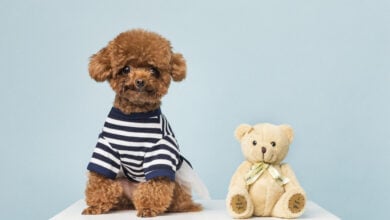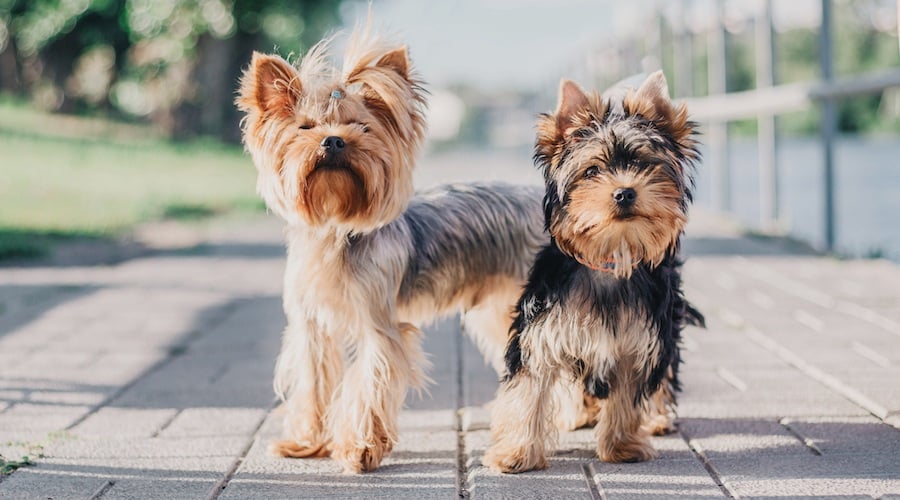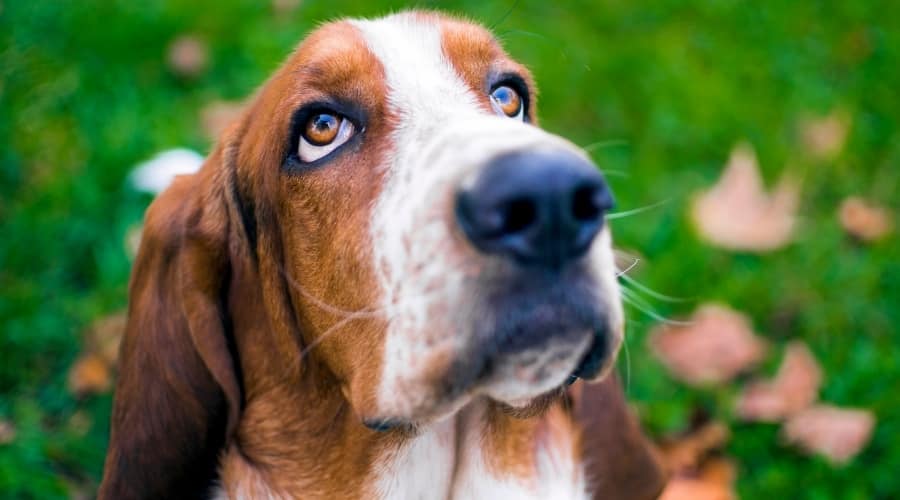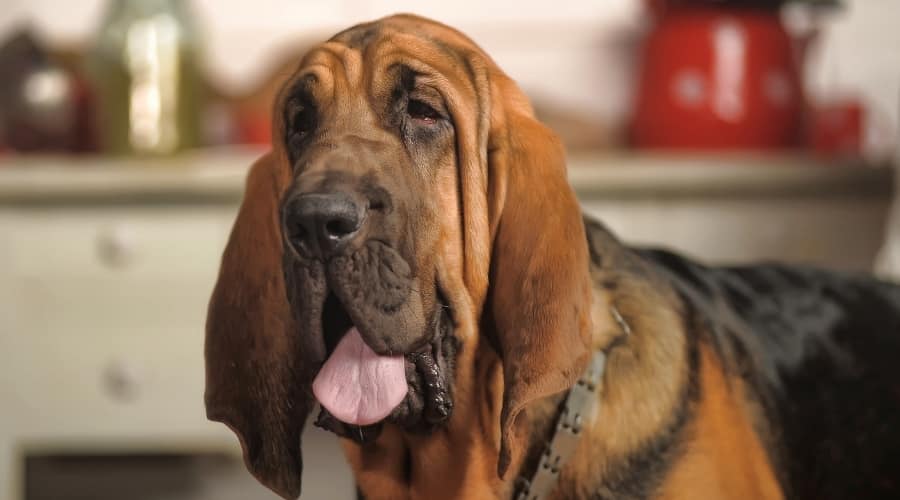18 Dogs That Look Like a Mop? They’re Ridiculously Cute!
When you purchase through links on our site, we may earn a commission. Here’s how it works.
At first glance, you’ll swear these dogs are cleaning supplies. But nope, they bark, they cuddle, and yes, they require a lot of grooming dedication. These dogs that look like a mop are 100% real and 100% extra.
Table of Contents
Whether you’re into fluff, cords, or a dog that doubles as a dust buster, this list has it all. Scroll down and meet 18 mop dogs that are so adorably weird they might just clean up your feed and your floors.
The Corded Crew: 3 Dogs With Natural Dreadlocks
These dogs don’t just look like mops. They are mops with muscles and barks. Their coats form long, rope-like cords that naturally mat over time, creating some of the wildest hairdos in the canine world. They’re big, bold, and born for mop memes.
1. Komondor
Looks like a bath mat with legs and bodyguard instincts.
The Komondor is a massive Hungarian livestock guardian known for their thick white cords that form naturally over time. These mop pups aren’t just for show. They protect the dog from weather, predators, and possibly unsolicited hugs.
Despite their serious job, the Komondor’s look is pure comedy: when they run, they resemble a runaway shag carpet. But make no mistake, keeping those cords clean and healthy takes serious work.
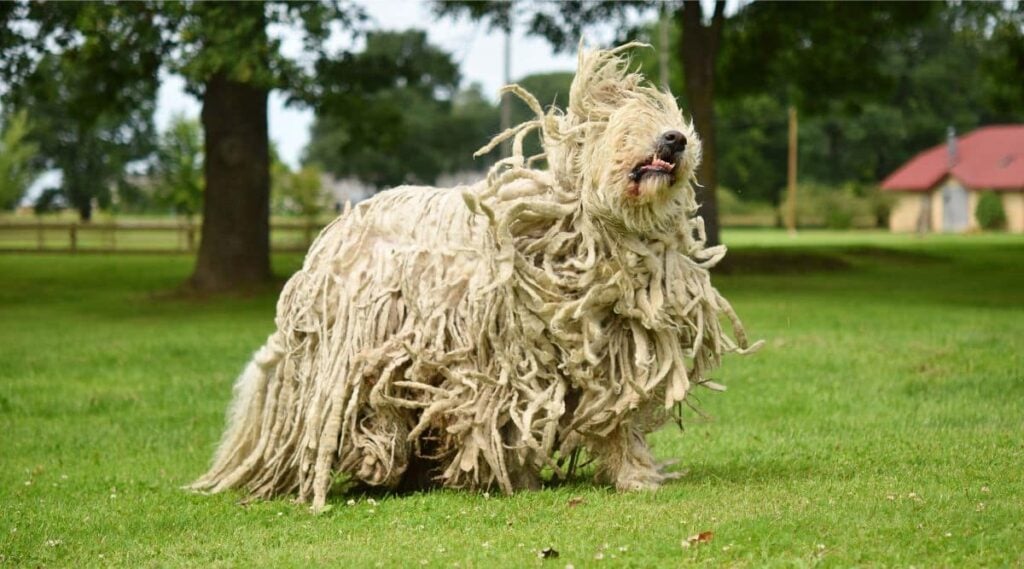
You don’t brush a Komondor’s cords, ever. Instead, their grooming routine is more like laundry day: diluted shampoo, a thorough rinse, and squeeze-drying with towels (yes, multiple).
Their coat clumps at the base in a process called “plating up,” and those plates need to be manually split into quarter-sized sections so they can form proper cords. Think dreadlocks but with way more effort and way less reggae.
Komondors are one of the largest mop dogs out there. Females typically weigh 80 pounds or more, while males often pass the 100-pound mark.
Despite their size, they’re surprisingly agile and light on their paws, with a confident, high-energy vibe. They need a human who can match their physical playfulness and preferably outrun them, which is no small task.
They’re also intensely independent and naturally protective, which makes them fantastic guardians but also a bit of a handful. Early socialization is key, and they thrive best with experienced, confident owners who understand how to channel that “I’ll guard this house to the death” energy into something a little more polite.
2. Puli
Imagine a mop mid-spin cycle. Now, give them zoomies.
The Puli is the smaller, spring-loaded cousin of the Komondor. This breed typically weighs between 25 and 35 pounds, sometimes up to a third of the Kom’s size. Their tightly coiled cords give them a look somewhere between a Swiffer head and a sentient deadlock.
Pulik come from Hungary and traditionally herd large flocks of sheep on the vast Hungarian plains. Bred for herding, they’re agile, smart, and absolutely obsessed with being where the action is. Their corded coat protects them from the harsh winters.
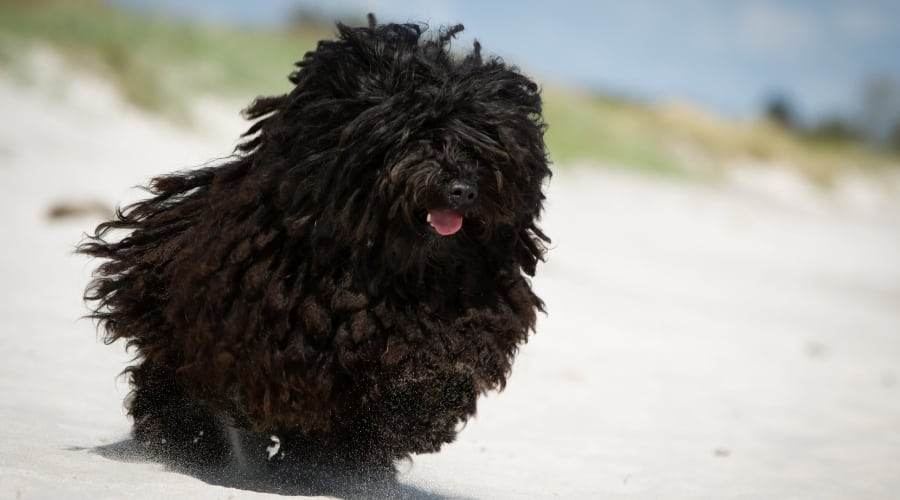
Just like the Komondor, their fur begins to mat at nine months, when you can separate the mats into cords. They have a similar grooming regime, but it takes a third of the time, thanks to being more compact.
Some owners choose to keep their coats short and brushed. Unlike the Komondor, who just comes in white, Pulik come in a variety of mop colors. Choose from black (the most common), white, grey, or cream dreads to suit your decor.
Pulik are better suited for more families than Komondors simply because of their more manageable size. But their herding instinct is still strong, and they herd whatever they can, whether other dogs, birds, or toddlers. Most are also very affectionate with their family.
3. Bergamasco Sheepdog
Looks like you left a wool sweater in the washer for a week.
The Bergamasco Sheepdog is Italy’s contribution to the mop-dog dynasty. Instead of cords, their coat mats into thick, felted layers that look like fuzzy rags stacked on top of each other. They fall right between the Puli and Komondor in size, typically weighing between 57 and 84 pounds.
They’re calm, clever, and surprisingly low-maintenance when it comes to grooming, despite the “I live in a medieval barn” aesthetic. Basically, they’re vintage rugs with great personalities.
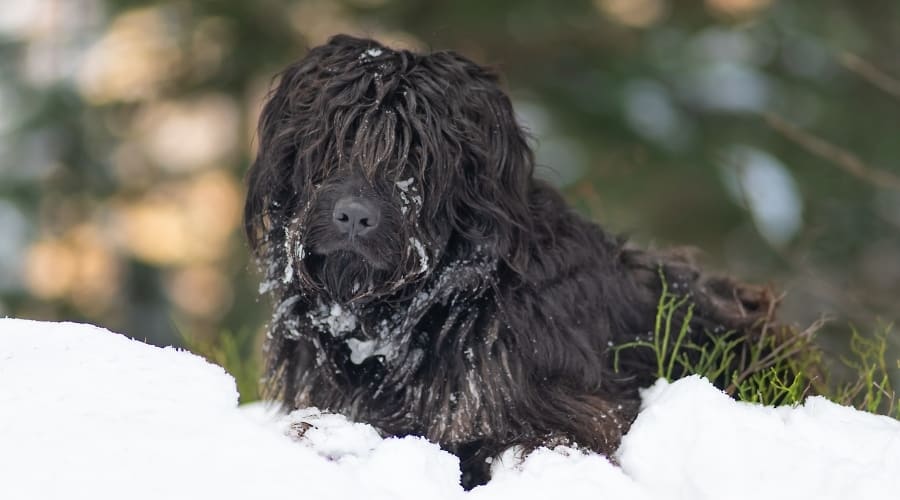
They’re strong, sturdy herders that originally worked the rocky slopes of the Italian Alps, specifically around Bergamo, near Milan. Their job? Guarding and guiding flocks of sheep in brutal alpine weather and looking like walking wool rugs while doing it.
Bergamascos are independent thinkers with a streak of stubborn brilliance, but they’re usually friendly, loyal, and incredibly devoted to their humans. They’re also one of the rarest mop dogs in the U.S., making them a pretty exclusive floof.
What really sets them apart is their layered coat, known for forming “flocks” – thick, flat mats of felted hair that can even fan out at the ends. This unique coat is made of three types of hair:
- A dense, oily undercoat that insulates and repels moisture
- Rough, “goat-like” outer hair
- Soft, woolly strands that bind everything together
Despite how complex it looks, their coat only needs a few baths a year, and no brushing is required. Nature designed them that way. Your vacuum will thank you.
6 Medium To Large Mops: Fluffy & Floor-Ready
These breeds may not have full-on cords, but they still bring maximum mop energy with thick coats, round shapes, and more fluff than function. They’re basically mops with feelings, and we love them for it.
1. Spanish Water Dog
Looks like a mop that just got dunked and is ready to party.
The Spanish Water Dog is a curly-haired working breed with strong roots in herding and water retrieval. Their coat grows in tight curls that can form cords, depending on care and texture, but even uncorded, they look like a shaggy bath mat mid-spin.
Smart, athletic, and loyal, they’re all business when working but total goofballs at home. And yes, as their name suggests, they’ll jump into any body of water with zero warning.
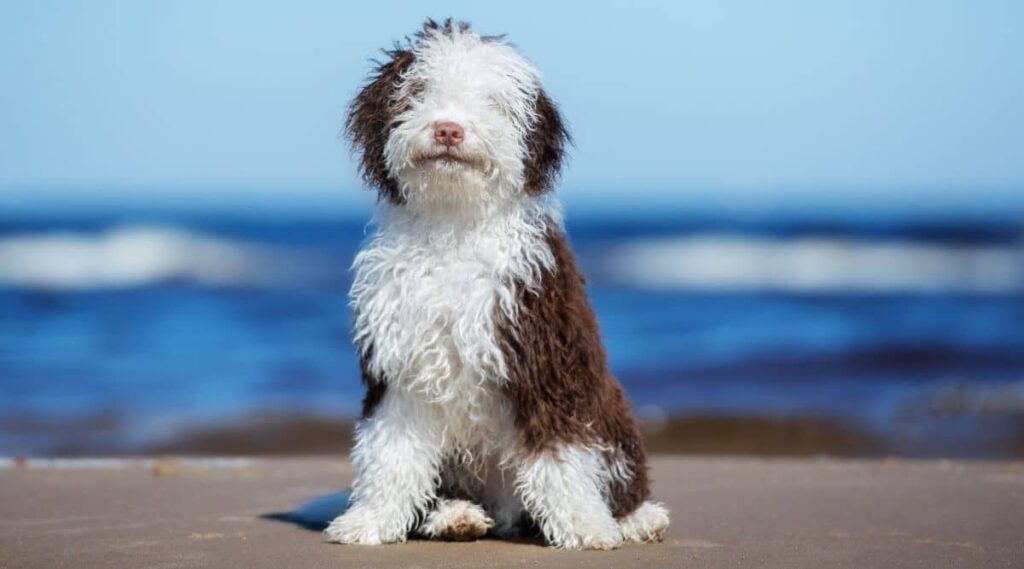
Spanish Water Dogs are in the herding dog group, but they are also waterfowl retrievers in their homeland.
They make a brilliant family companion for most active families who can give them at least one hour daily. This needs to be intensive exercise, not just a stroll, as they are inexhaustible. Once you have satisfied their exercise needs, they are happy to chill at home and give the best cuddles.
Their curly, woolly coat should never be brushed. How short you let their coat grow is up to you, although many owners choose to let their hair grow long, eventually forming cords.
The Spanish Water Dog’s cords are different from other breeds on this list, and if you want your pup’s hair to cord, you should find a groomer with experience in their coat. Their coats are usually a mixture of beige or white and brown or black, although some have a full brown or black coat.
2. Barbet
Looks like a French mop that drinks espresso and knows art.
The Barbet (pronounced bar-bay), darling, is a rare French breed with dense, curly fur that can make them look like a living pile of noodles. Traditionally used for waterfowl retrieval, they’re athletic and love swimming, but their appearance screams “overgrown bath loofah.”
They’re also charming, easy-going, and surprisingly adaptable if you can keep up with the grooming. That curl doesn’t maintain itself.
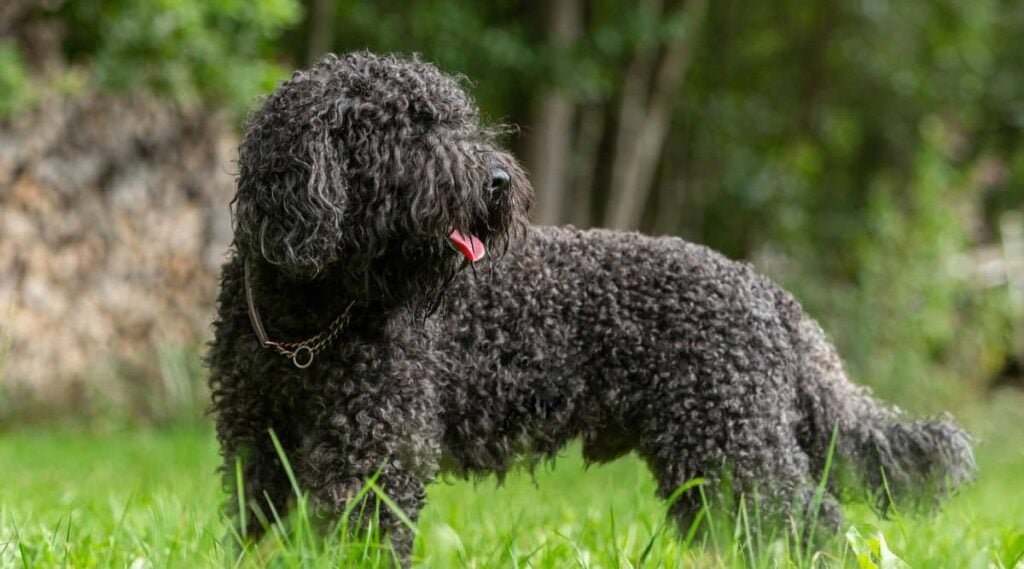
The Barbet is a medium-sized dog that weighs between 35 and 65 pounds. They are eager to please and intelligent, making them an all-around great mop dog to train. After a day of training, they love to cuddle. Think Velcro energy with soft, fluffy texture.
The Barbet is covered from head to paw in a dense, curly coat, which can be brown, fawn, gray, or black. Barbets are often compared to a Muppet, crazily shaggy in appearance but friendly in nature.
Grooming a Barbet can be intense if you want to groom them according to their traditional appearance. It can take several hours, including a full brush out, a thorough wash in the bath, blow drying, trimming the hair, wetting it down, and then letting it air dry to regain its natural curls.
3. Briard
Looks like someone blow-dried a shag rug and gave it legs.
The Briard is a large French herding dog with a luxurious, slightly wavy coat that drapes all the way to the ground. Their serious face hides a goofy personality. They’re loyal, playful, and very into their humans.
While not corded, their coat is so dense and layered that it gives off major mop energy, especially when they’re trotting across the yard with their ears flopping like dusting rags.
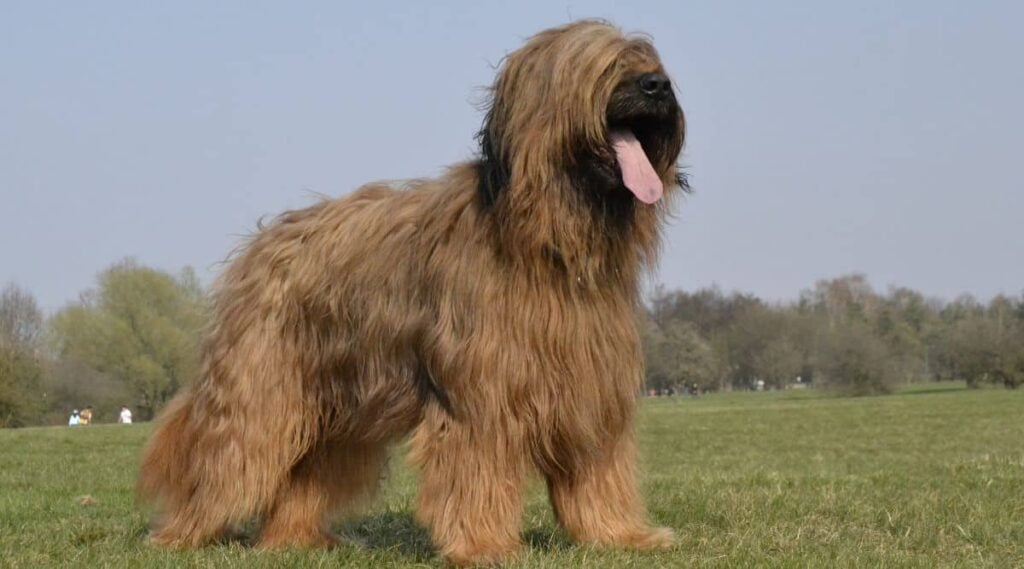
These French pups are brilliant herding dogs, and just two Briards can handle 700 sheep. They are also fantastic guard dogs, so they are a top choice if you’re after a watchful mop to keep an eye on things.
Briards are incredibly hardworking, and first-time owners might find their zest for activity too overwhelming. But if you have the energy for them, most make lovely family pets, and they are often described as “heart wrapped in fur.”
Their coat is long and wavy, with a peek-a-boo hairdo that parts naturally to show their eyes. They need a thorough brush several times a week to prevent their long coat from matting right down to their skin.
You need a good quality, soft-ended pin brush to protect their skin from scratches. Depending on their lifestyle and how dirty they get, they might need weekly, monthly, or less bathing.
4. Old English Sheepdog
Looks like a giant, rolling cotton ball that ate a broom.
This big, lovable fluff monster is the very definition of mop-shaped chaos. The Old English Sheepdog’s dense double coat is soft, thick, and somehow always seems to be in motion, even when they’re not.
Originally bred for herding cattle and sheep in the English countryside, they now mostly herd their family for attention. If you’ve ever wanted a dog you can hug and lose your socks in, this is the one.
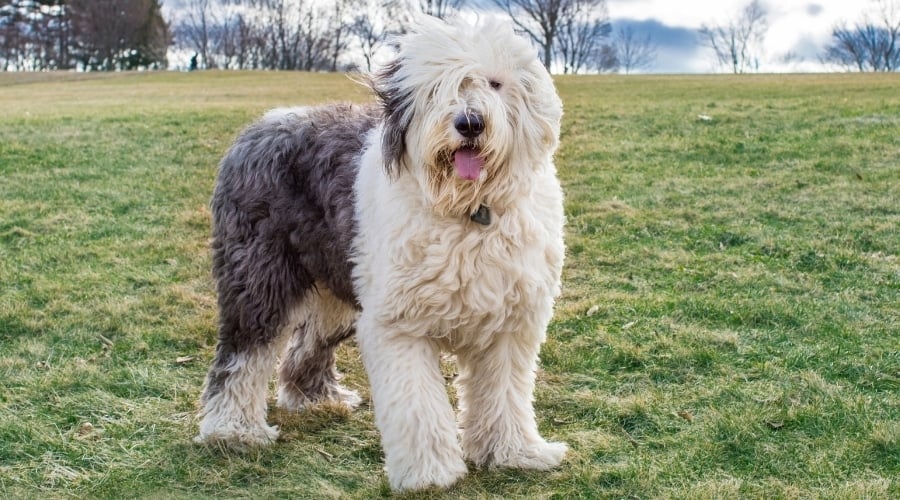
The Old English Sheepdog, also known as the Bobtail, is the epitome of shaggy dogs. Nowadays, most make brilliant family companions and are often affectionate, gentle with children, intelligent, reliable, and watchful. They have a fun-loving and adaptable nature, with a unique bear-like shuffle and a loud bark.
Bobtails are large dogs that usually weigh between 60 and 100 pounds. They have a thick, wavy double coat that needs grooming several times weekly.
Given all their hair, giving them the thorough brush they need can take a long time. Bathtime and drying can be laborious and tricky, which is why many Bobtial owners send them to a professional groomer regularly.
5. Bearded Collie
Looks like a mop that runs on joy and chaos.
The Bearded Collie (aka the “Beardie”) is a shaggy, bouncy ball of energy wrapped in a silky, sweeping coat. Always cheerful, always shedding, they practically levitate when they run.
Their hair flows like fringe on a festival outfit, making them look more like a well-loved cleaning tool than a dog. But their upbeat vibe and affection for people make them anything but disposable.
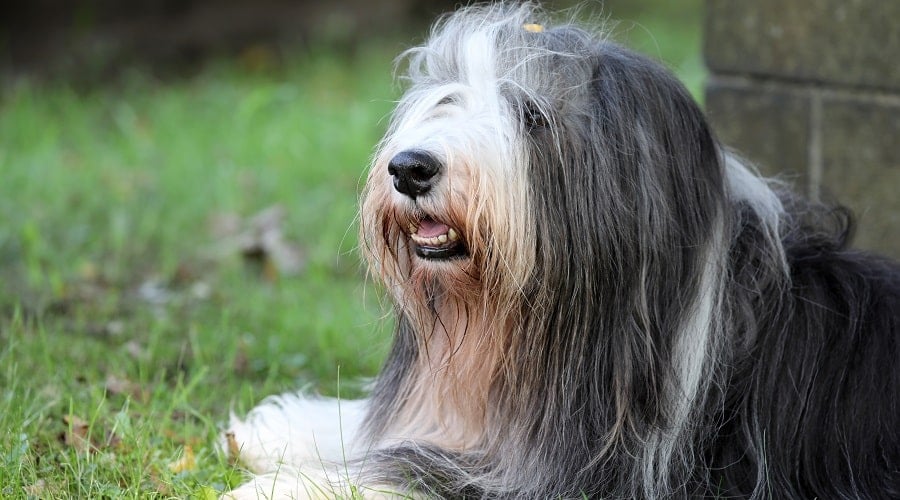
The Bearded Collie is similar to the Old English Sheepdog but much smaller and, therefore, less hairy. Their grooming regime is similar, although it takes less time, thanks to their more petite frame.
They have a long, double coat that needs brushing several times a week to prevent tangling and remove dirt and debris that this mop dog picks up on their travels. How often you bathe them depends on how muddy and dirty they get.
Canine historians believe they are closely related to our top mop dog, the Komondor. They are prized by Scottish farmers who require a hardworking herder and drover on the harsh and hilly terrain.
They are boisterous and charismatic, often making brilliant family pets for most active families and often gentle playmates for most children.
6. Afghan Hound
Looks like a hair commercial got lost and became a dog.
The Afghan Hound doesn’t just walk. They glide like an angel. With their long, silky coat and regal posture, they look more like a fashion model than a mop.
But make no mistake: under all that glamour is a rugged athlete bred for hunting in the harsh mountains of Afghanistan. They’re fast, independent, and famously aloof, kind of like a cat, but with better cheekbones.

Afghans are high-maintenance in every sense. Their coat tangles easily and demands regular brushing and bathing to stay camera-ready. They know they’re stunning, and honestly, they expect you to know it too.
Their silky, flowing coats need brushing several times a week, if not daily, to keep their long locks looking fabulous and clean. They are medium-sized pups weighing between 50 and 60 pounds.
They are eye-catching regal, so they have always been a favorite Fido for royalty and aristocrats worldwide. Despite their graceful appearance, they are powerful and nimble-footed sighthounds and have explosive power when pursuing their prey.
They are sweet pups but can be independent and stubborn. First-time owners might find their independent nature, exercise, and grooming needs too intense. But for the right family, they make special pets.
9 Tiny Mops You Can Hold in One Hand
They’re compact, cute, and shockingly mop-like. These toy and small breeds bring maximum fluff with minimum floor space. And most have a permanent “just got out of the dryer” look.
1. Havanese
Looks like a microfiber mop that demands constant affection.
The Havanese, once called the Spanish Silk Poodle, is Cuba’s national dog and possibly the world’s leading lap mop. They’re known for their silky, flowing coat and bright, people-loving personality. However, not many people know you can dread their hair!
Smart, trainable, and always down to cuddle, they make ideal companions for apartment dwellers as long as you’re ready to brush. Daily. No exceptions. Plus, you need to keep their barking in check because they are also keen watchdogs.

However, if you prefer the long, silky, mop-like jacket, you can stick with that. Others clip it short to minimize grooming time. If your pooch has a long coat, it needs brushing several times a week to keep it tangle-free.
Because Havs are so small, weighing 7 to 13 pounds, grooming can be done while sitting on your lap, and boy, do they love the attention. Havenese sport a wide variety of colors, too.
Havanese are friendly and comical and make wonderful pets for most families. Their easy-going and biddable nature makes them a top choice for first-time owners. Plus, they have a typically long lifespan, too.
2. Tibetan Terrier
Looks like a high-end shag rug with a sixth sense for vibes.
Despite the name, the Tibetan Terrier isn’t a true terrier. They’re more of a mop-shaped monk with major emotional intelligence. Originally bred in Tibetan monasteries, they were considered lucky charm dogs.
With a long, flowing double coat and oversized snowshoe paws, they’re as fluffy as they are soulful. Friendly, sensitive, and surprisingly athletic, they’re perfect for people who want a wise companion wrapped in fur.
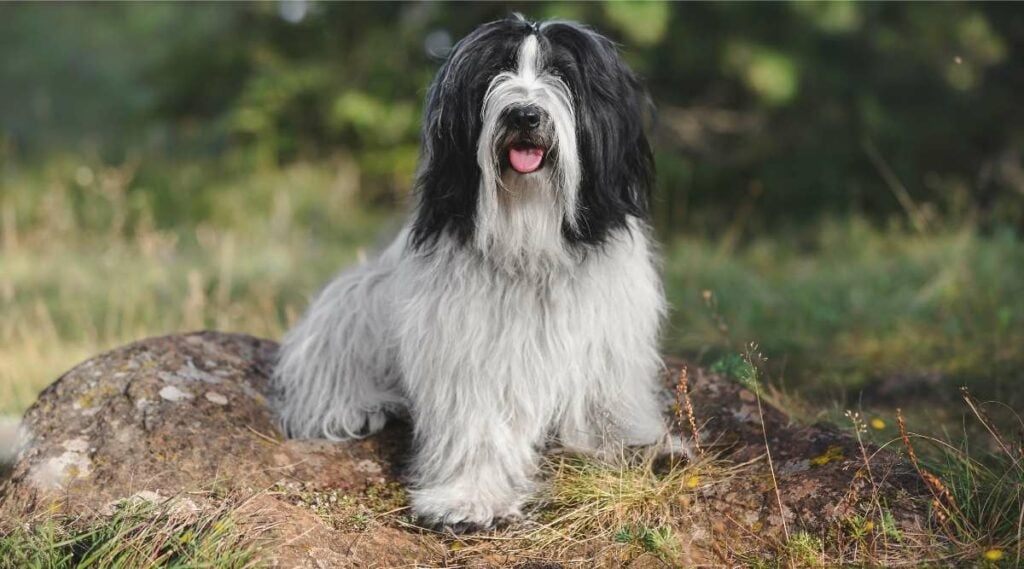
The Tibetan Terrier is also called “The Holy Dog of Tibet,” so read on if you need a blessed mop. They are sweet and gentle with their family, although reserved and suspicious of outsiders, making them excellent watchdogs.
Their coat is thick and long, although some owners keep them in a puppy cut as it is easier to groom and more convenient for everyday life. If you like the manicured and flowing mop-like coat, brush it several times a week to keep it in good and clean shape.
Over the centuries, their feet have developed into large, flat, and round paws, producing a snowshoe effect. This gives them traction in the snow, making them a fantastic choice for active families living in cold and snowy areas.
3. Pekingese
Looks like a shag carpet, sounds like a grumpy old man.
Small in stature but big on attitude, the Pekingese is a royal relic from ancient China with a seriously dense coat. They’re compact, proud, and often a bit snarky, which just adds to their mop-like charm.
Their lion-like mane makes them look twice their size, especially when they sit still and resemble a slightly offended floor mat.
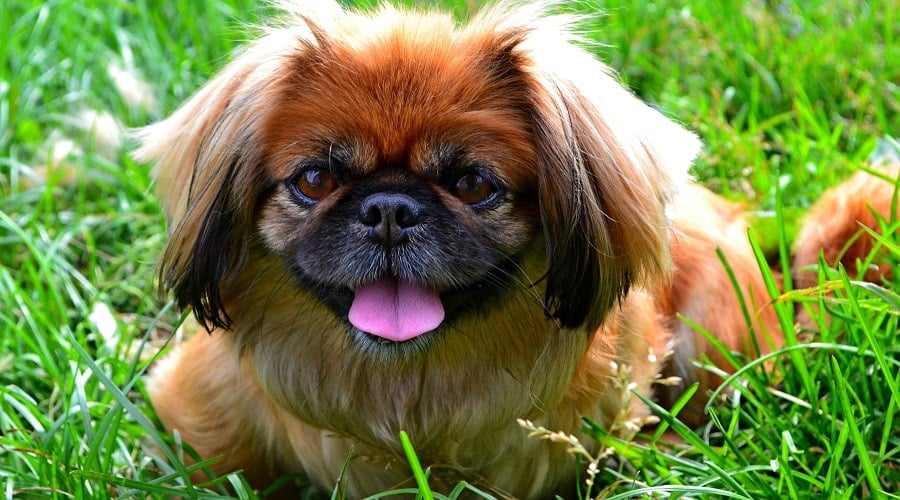
The Pekingese is a unique-looking dog, mainly because of how short and wide they are and their envelope-shaped head.
Brush them several times a week to remove loose hair and dirt. They don’t require many baths because these pups are true lapdogs, rarely getting muddy.
Pekingese are regal and charming, affectionate with their close family, and form a close bond with their primary caregiver. They don’t have much time for outsiders, and they don’t appreciate rumbunctious kids.
Don’t let their small size fool you. They are opinionated and very independent thinkers, and because of this, they can be tricky for first-time parents. These charming pups weigh up to 14 pounds.
4. Bolognese
Looks like a powder puff and a kitchen mop had a love child.
This Italian fluffball is the quiet cousin of the Bichon family. Bolognese weigh between 6 and 10 pounds, making them one of our list’s most miniature mop-like dogs.
With a thick, cottony white coat and a clingy personality, they’re equal parts lapdog and loyal shadow. They don’t shed much, but they do mat easily. So keep that grooming schedule tight unless you’re aiming for the “abandoned feather duster” aesthetic.
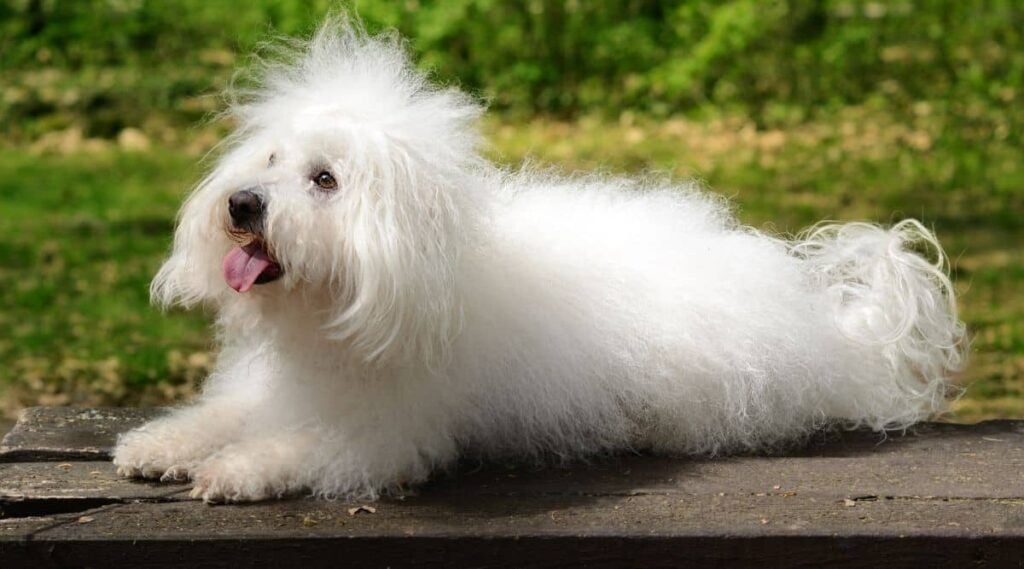
Bolognese are charming companions, intelligent, sometimes stubborn, and comical. They are usually low-energy dogs with calm personalities, ideal for many busy families with young kids. They are rare in America.
The Bolognese has a pure-white coat, which is long and fluffy with a cotton texture. Unlike many other breeds on this list, they are ‘non-shedding,’ making them an excellent choice for low allergy sufferers.
If you keep their coat in full, it requires grooming several times a week to prevent matting. Some owners cut it short for ease but usually keep their distinctive and explosive mop head hair.
5. Lhasa Apso
Looks like a long-handled mop guarding a Himalayan temple.
Originally bred as indoor sentinels in Tibetan monasteries, Lhasa Apsos are small but serious. Their floor-length, parted coat gives them a refined look as if they’re guarding your home’s energy flow.
Lhasa Apsos are smart, confident, and a bit aloof with strangers. They’re basically wise pups disguised as dust bunnies.

The Lhasa Apso is commonly called the “bearded lion dog.” They are an ancient breed from Buddhist monasteries in the Himalayan mountains. Lhasas served as indoor guard dogs, while larger Mastiff dogs stood guard outside.
So, this could be an excellent choice if you’re after a little guard mop that only weighs between 12 and 18 pounds. They are sweet with most children, love their family, and are very comical. Although they are aloof with strangers, don’t expect them to be sociable outside their family unit.
Their facial hair also parts in the middle of their head, only just revealing their sweet eyes. Whether you choose a long or puppy haircut, they both require maintenance. Lhasas with lavishly long hair need a bath at least every two weeks. Be sure to rinse and dry them thoroughly because they have sensitive skin.
6. Maltese
Looks like a show mop that entered a beauty pageant and won.
The Maltese is one of the oldest toy breeds in the world, and their glossy, snow-white coat is the stuff of shampoo commercial dreams. Their show-stopping coat falls to the floor, straight and silky in texture.
Underneath that fluff is a bold, affectionate personality that loves being the center of attention. They’re divas in disguise but with serious cuddle energy. They are tiny dogs that weigh under seven pounds, making this dinky doggo one of the smallest on our list.
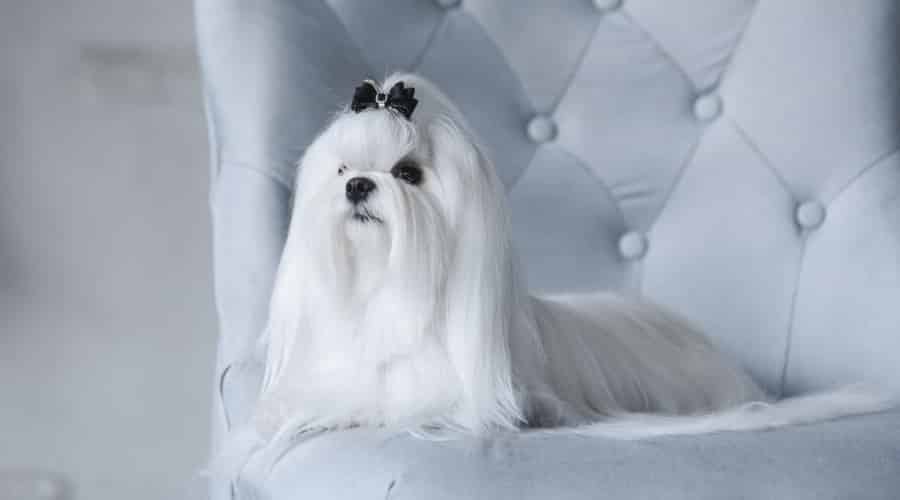
Maltese are low-shedding but require daily brushing to keep them clean and tangle-free. They need regular bathing, and like many small dogs with white coats, tear-staining is common.
Maltese hail from the small island of Malta, which sits in the middle of the Mediterranean Sea. This pooch is an ancient breed with an exotic history. But one thing hasn’t changed: they are proper companion dogs who expect a life of luxury.
Greeks erected tombs for their Maltese, and Egyptians worshiped them. So, if you’re looking for a tiny posh mop, this pup is a top choice.
7. Shih Tzu
Looks like a velvet mop that rolled out of a royal palace.
Once prized by Chinese emperors, the Shih Tzu brings imperial energy in a mop-shaped body. Their long, dense double coat can be kept floor-length or styled into a manageable teddy bear cut. Either way, they strut through life with confidence and absolutely zero self-awareness about their mop status.
The Shih Tzu is one of the most popular dogs on our list, commonly found in family homes nationwide. They are playful, affectionate, and outgoing, making them great companions for most kids and adults alike.
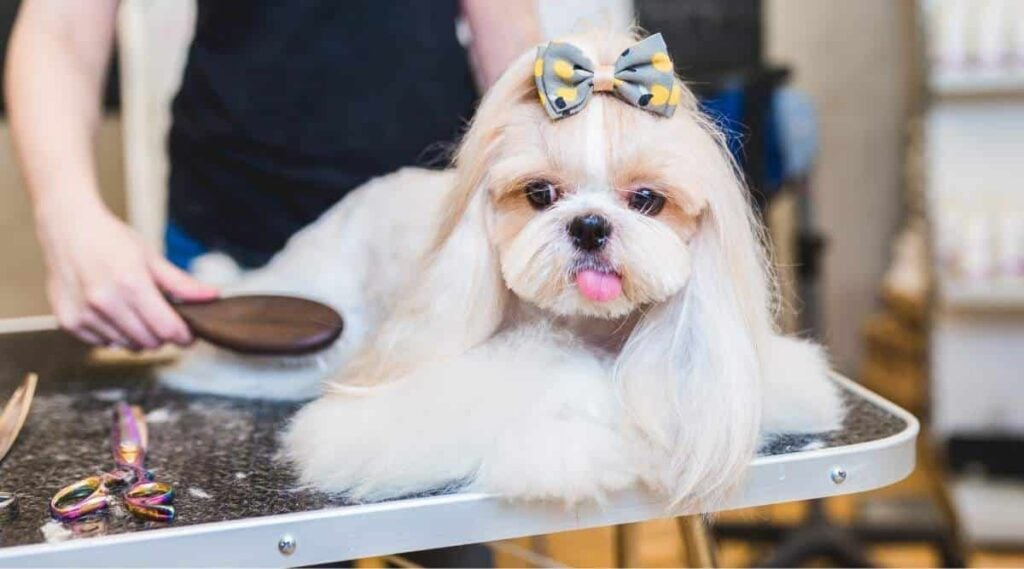
Shih Tzus only weigh between 9 and 16 pounds, but they are playful and sturdy dogs that give as good as they get in play. There is never a dull day with a Shih Tzu around. Their life expectancy is 10 to 18 years, so they are long-living mop dogs, too.
Their traditional coats sweep the floor and require daily brushing. Long coats need bathing every four weeks to keep them looking and feeling healthy.
You might need to tie their long facial hair into a topknot so they can see their cute button eyes. Their coat comes in a wide range of doggy colors and markings and is silky in texture.
8. Skye Terrier
Looks like a vintage push mop with serious side part energy.
The Skye Terrier is long, low, and loaded with glam. Their thick coat flows straight down both sides like a curtain, and their signature side part gives them permanent red carpet hair.
Originally bred to chase in tight spaces, they’re dignified, devoted, and hilariously dramatic when ignored. They are from the Scottish Isle of Skye and were bred to be fox and badger exterminators. Skye Terriers are extremely hardy breeds with a high prey drive.
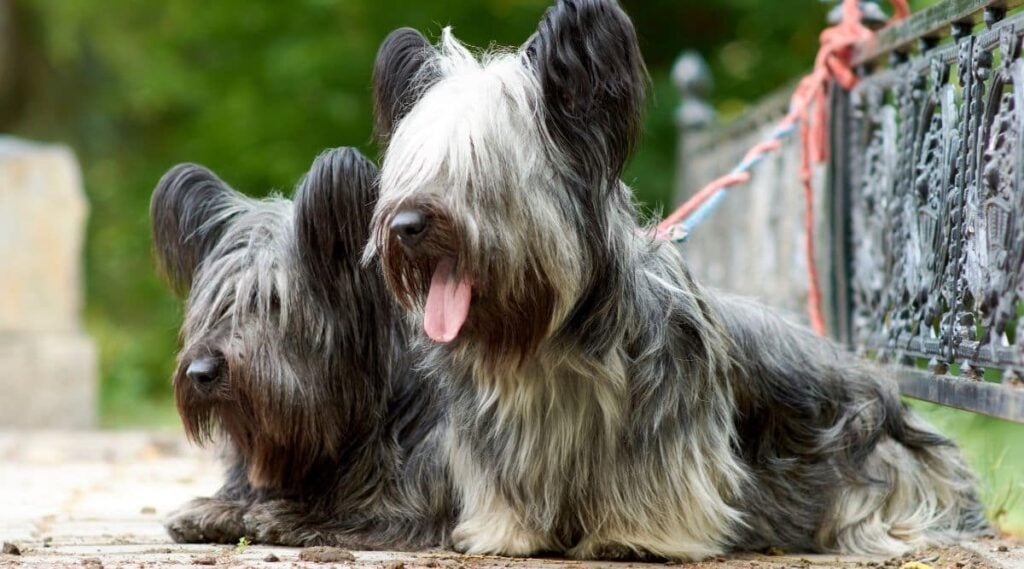
The Skye Terrier is a medium-sized dog weighing 45 pounds and under. Their large, pricked, feathered ears with natural highlights are the star of the show here.
They are also super affectionate with their family but suspicious of strangers, making them a relaxed companion in the right family setting. Be warned, they are incredibly stubborn, and training one can be tricky.
Skye Terriers have a long, double coat that looks more difficult to groom than it is. They are rugged dogs, and their coat should be left natural.
They only need brushing twice a week to stay healthy and prevent matting, and they only need bathing every month or two. You shouldn’t scrub their hard coat with shampoo when bathing them because this can cause them to mat.
9. Yorkshire Terrier
Looks like a floor mop that just left the salon.
Last but certainly not least is the Yorkie. This is the most popular dog on our mop list and is consistently in America’s top 15 most popular dog breeds.
The Yorkie may be tiny, but their hair game is unmatched. With a silky, glossy coat that often grazes the floor, they’re basically the glam rock stars of the toy dog world. Smart, sassy, and fiercely attached to their humans, they’re all bark, all heart, and all hair.

Many owners give their Yorkies a puppy coat to reduce grooming time. However, a traditional Yorkie or Yorkie in the showing must have a long coat that sweeps the floor. Their coat is similar to human hair and needs daily brushing and weekly washing.
Don’t let their dainty size of 7 pounds fool you. They are feisty, courageous, and tomboyish. A true terrier! They are full of comical canine character, packed into a tiny body.
Yorkies are long-lived and provide some of the best canine companionship you could ask for. This mop-like dog often suffers from separation anxiety and does not like to be left alone for too long.
Grooming Drama: What No One Tells You About Owning a Mop Dog
Sure, they’re adorable. Yes, they look like magical dust bunnies sent from the heavens.
But behind every mop dog is a human silently sobbing into a brush or towel. Because here’s the thing: That fluff doesn’t maintain itself.
If It Cords, It Complicates
Corded breeds like the Komondor, Puli, and Bergamasco don’t get brushed. That sounds easy until you realize what you’re signing up for: plate separation.
This means manually pulling apart clumps of fur down to the size of a coin so they can develop into cords instead of felted disasters. It’s not brushing. It’s sheepdog origami. And it’s not for the faint-hearted.
Bathing them? Imagine washing a full-size cotton mop, then squeezing out up to 80+ pounds of wet dreadlocks with towels. Drying takes hours. Trapped moisture can cause skin infections and other problems. Drying wrong takes weeks to recover from.
All these reasons and more are why many owners of these mop dogs find a professional and trusted groomer with lots of experience with corded mop breeds.
If It Flows, It Tangles
For the silky, flowy types like the Afghan Hound, Maltese, or Yorkie, the struggle is also real and constant. Their coats are basically hair extensions with feelings. Skip one brushing session, and you’re dealing with a mat the size of a grapefruit behind their ear.
Some owners trim these breeds down into puppy cuts for ease. Others go full glam and invest in bows, detangling sprays, and deep conditioners. Either way, this is not a wash-and-go situation.
And Then There’s The Furniture
Mop dogs don’t just look like your rug. They claim your rug. Their hair collects dust, snacks, and entire civilizations of fur tumbleweeds. You will find strands in your fridge. In your coffee. Possibly in your soul.
If you want a mop dog, get a good groomer, a quality slicker brush, and a vacuum that deserves hazard pay. Mop dog owners are not just pet parents. You’re a live-in stylist.
Top 5 Mop-Grooming Tools You’ll Actually Use (& Need)
- Slicker Brush – Great for detangling silky coats on breeds like Maltese, Yorkies, and Shih Tzus without pulling or damaging hair.
- Blunt-Tip Grooming Scissors – Ideal for safely trimming mats, paw fluff, and those awkward face fuzzies without any accidental snips.
- Dog-Safe Detangler Spray – Makes brushing way easier and prevents “screaming into the brush” moments when mats get out of control.
- High-Velocity Dog Dryer – A must-have for corded breeds and heavy coats. Towel-drying won’t cut it; this blasts moisture out of the fluff.
- Microfiber Towels (Lots of Them) – For squeeze-drying cords, catching post-bath drips, and mopping up your own tears after grooming day.
Final Mop-Dog Thoughts
Now you know all about the dogs that look like mops. From large canines to teeny-tiny ones, some with cords, others with human-like silky hair, there is a different mop lookalike for every dog lover.
And remember, just because they look like a mop doesn’t mean they should smell like one. Take good care of their coat to ensure a happy hound and an aroma-free home.
How To Keep Your Mop Dog Happy & Healthy
Owning a mop dog is part grooming, part love, and part lifestyle, but there’s more to keep them healthy than just detangling their curls and keeping their cords clean.
It all starts with high-quality dog food, which fuels their skin and coat from the inside out because glossy mop fur doesn’t happen on bargain kibble. Adding a daily fish oil supplement can help reduce shedding, boost skin health, and keep their coat looking and feeling good.
Don’t forget interactive dog toys, especially for the smart, independent mop breeds. They need mental stimulation just as much as physical exercise to stay sane (and to stop redecorating your living room).
Annual vet visits help catch potential issues early. And finally, consider pet insurance because treating unexpected medical issues can get expensive fast, and you never want to choose between their health and your savings account.
A happy mop dog is a clean, fed, stimulated, and covered one. And when they’re thriving, your home becomes part palace, part comedy show, and part cuddle pile.
Got a mop dog of your own? Drop their name, breed, and the weirdest thing you’ve ever pulled out of their fur in the comments. We want the fluff, the chaos, and the corded glory gossip.
